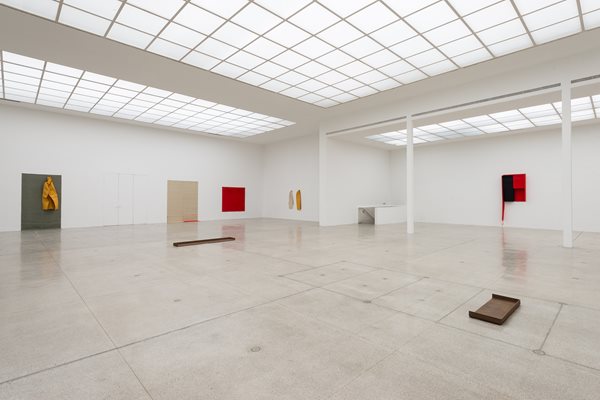Info Details
2015: Werkvorführung Franz Erhard Walter in der Secession Wien
With Franz Erhard Walther, one of the most authoritative contemporary artists, the evn collection, founded in 1995, opened its 20th anniversary year on Jan. 29, 2015.Franz Erhard Walther's works, actions and analyses have inspired elementary investigations by art professionals, and have decisively influenced generations of artists. He has developed and established a body of work that could not be more complex or revolutionary. The aplomb and self-evidence with which he changed the 20th century's conceptions of the image also makes current developments in art seem clearer.
Franz Erhard Walther was born in 1939 in Fulda into a family of bakers. Later he will notice that the methods of this craft are reflected in his work: the principles of dividing, packing, layering, covering, the effect of material. In Offenbach, he attended the Werkkunstschule and discovered hatching as a means of expression. When he shows a small selection of his works in his hometown for the first time in 1964, there is an art scandal that is commented on in detail in the regional press. In 1959 he studied at the Städelschule in Frankfurt and began to explore the process of changing material as a form of work. He created works on paper by bending, folding, tearing, gluing, and soaking, works that he lined up, laid out, stacked, layered, placed, and hung. When in 1961/62 he declared the backs of painted pictures to be valid works, the professors regarded this as "a provocation not befitting German art colleges" and arranged for the compulsory de-registration of an artist who had never been concerned with destruction, but with the expansion of art into the social dimension. In 1962-64 he enrolled with the informal painter Karl Otto Götz in Düsseldorf, where at the same time Gerhard Richter, Sigmar Polke and Konrad Lueg alias Konrad Fischer were also studying. He uses liquids such as vegetable oil or coffee. They penetrate the paper, gradually spread out and seep through to the reverse side; instead of merely serving as a ground for various representations, a concretely worked, flat body emerges.
In contrast, Walther develops fabric works made of cotton, which his former wife Johanna sews in her parents' tailor shop. In the following six years, the total of 58 parts of the 1st work set are created, with which Walther realizes that fundamental idea that will force modern art to rethink: In this groundbreaking work of Conceptual Art, he replaces the process of changing materials with open actions that the recipient performs with the workpieces. For the first time in the history of art, the relationship between the concept of the work and the experience of art is reformulated: It is understood as action, the viewer as user. Walther establishes his other concept of the work, which claims event, body and participation for itself and uses the recipient as a producer, to whom the artist provides a set of instruments.
In 1965 the gallery owner Heiner Friedrich enables him to go to New York, where he decorates cakes in a pastry shop. Kasper König publishes the first book "Objects, Use," and Bazon Brock euphorically comments on it as "an example of art overcoming art." Solo exhibitions in leading avant-garde galleries are followed by participation in Harald Szeemann's legendary Bern exhibition When Attitudes Become Form.
In 1970 Walther was appointed by New York to the Hamburg Hochschule für Bildende Künste, where he taught until 2005, and in 1972 he received his first invitation to the documenta in Kassel, where he participated four times.
Walther's workpieces are comparable to functional instruments and tools that are to be handled in a certain way dictated by their material composition. Deciding how to handle the pieces is a mental process of shaping. Everything can become the material of this work to be produced by the recipient and not by the artist: Time, thought, language, emotion, weather, or space are possible work-materials, but so are other people. The classical unity of the work breaks down into a material part produced by the artist and an immaterial part to be formed mentally by the recipient. After 1969, work complexes emerge such as the 2nd set of works with walking pieces and spatial works and the extensive group of wall formations made of neutral and strongly colored cotton fabrics, which Walther concludes in 1997. The instrumental character of the earlier works now combines with the intense presence of the installations to form complex fields of experience and relationships. People moving into the installation are an integral part of the work and a sculptural element.
For the work screening at the Secession, two works will be permanently installed in the room:
Werklager, Sockelsammlung, 1984/86, from the collection of the MUMOK, Museum moderner Kunst Stiftung Ludwig, Vienna (the work was already shown at the Secession in 1989).
2 Körperformen, Schwarz, Rot, 1983, a new acquisition of the evn sammlung.
In addition, the works 2 Schreitsockel, 1975, as well as three legendary objects from the 1st set of works can be activated by the public:
4 Fields, (No. 21, 1st set of works) 1966.
Object shortly before dawn, (No. 32, 1st set of works) 1967
4 body weights, (No. 42, 1st movement) 1968
With many thanks to the Wiener Secession (Herwig Kempinger, Silvie Liska, Annette Südbeck), Susanne Neuburger (mumok), Nikolaus Oberhuber (KOW Berlin), Andreas Reiter Raabe and Susanne Walther.
Text: Brigitte Huck, curator of the evn collection.
